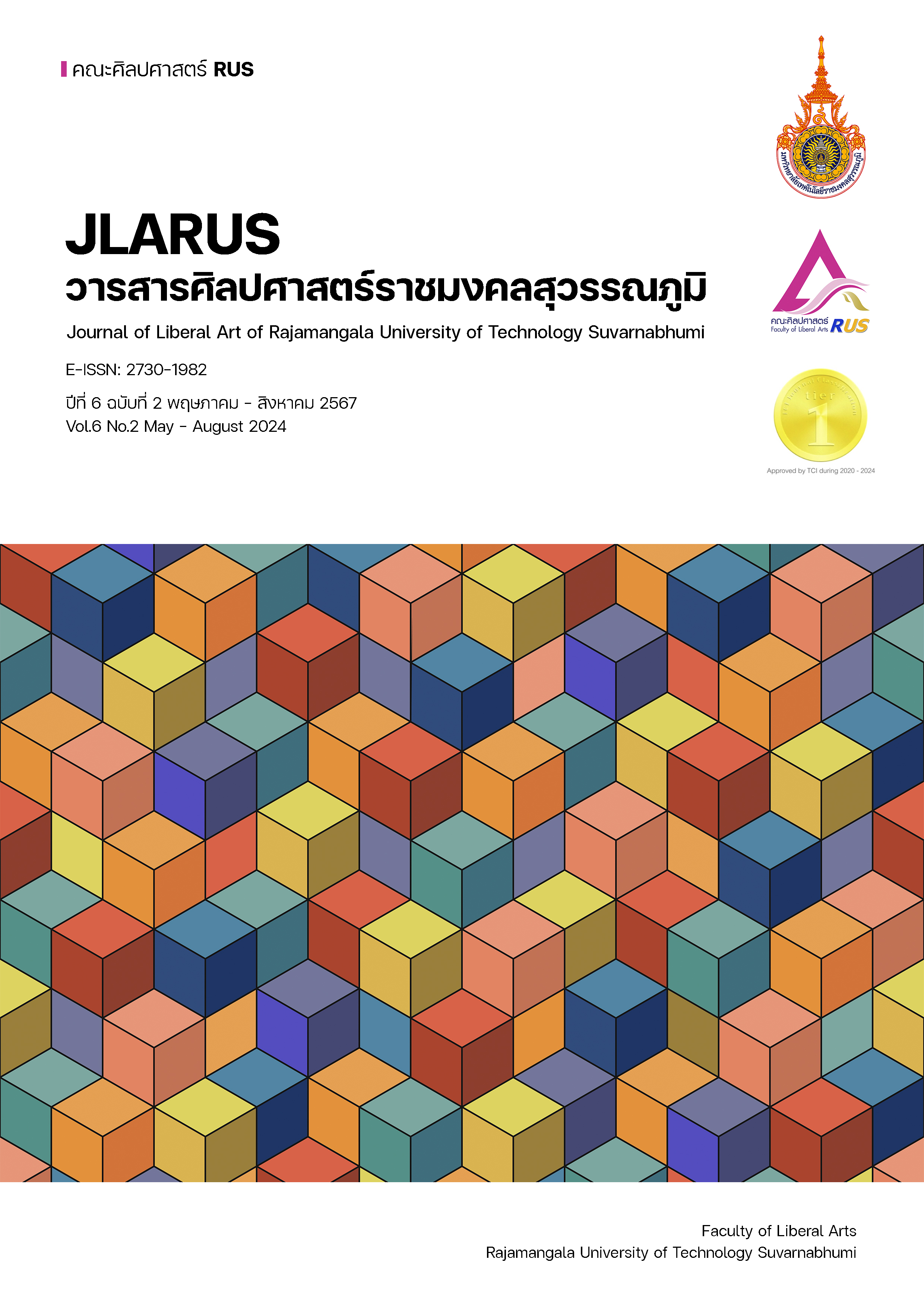THE INNOVATION OF PROMOTING MANAGEMENT FOR TRADE COOPERATION BETWEEN THE PUBLIC AND PRIVATE SECTORS OF THE NONTHABURI CHAMBER OF COMMERCE
Main Article Content
Abstract
The purposes of this research were: 1) to investigate the current operational situations of The Nonthaburi Chamber of Commerce's trade cooperation issues and impediments, 2) to explore ideas to address obstacles and hurdles in trade cooperation between the public and private sectors of the Nonthaburi Chamber of Commerce, and 3) to build a management innovation model and promote trade partnership between Nonthaburi Chamber of Commerce's public and private sectors. The research was qualitative. In-depth interviews and focus groups were conducted. There were 35 significant informants.
According to the research findings: 1) Trade cooperation between the public and private sectors of the Nonthaburi Chamber of Commerce had the current operational environment and essential missions across the country including fostering collaboration with all sectors of society (Connect), increasing the country's competitiveness (competitive), and passing down sustainable guidelines to future generations (Sustainable). 2) Nonthaburi Chamber of Commerce guidelines for resolving difficulties and overcoming barriers to trade collaboration between the governmental and private sectors. originating from the external environment was an issue that could not be resolved immediately. Thus, the Chamber of Commerce must be governed, promoted and supported trade to comply with the law in order to promote trade cooperation between the public and private sectors. 3) An innovative management strategy to foster trade cooperation between the Nonthaburi Chamber of Commerce's public and private sectors had developed the commercial network approach of the public and private sectors into an innovative approach for managing trade cooperation between the public and private sectors (CCSGP Model).
Article Details

This work is licensed under a Creative Commons Attribution-NonCommercial-NoDerivatives 4.0 International License.
References
กศมา ปาไทย. (2566). ความร่วมมือภาครัฐและเอกชน ในการพัฒนาทุนมนุษย์เพื่อการรักษาโรคหัวใจของศูนย์หัวใจเซฟฮาร์ท การแพทย์ กรุ๊ป. วารสารมหาจุฬานาครทรรศน์, 10(1), 28–45.
นภัทร์ แก้วนาค. (2555). เทคนิคการวิเคราะห์ข้อมูล (Qualitative Data Analysis Technic). เอกสารประกอบการสอนหลักสูตรการวิจัยและพัฒนาหลักสูตร, กรุงเทพมหานคร: มหาวิทยาลัยศรีนครินทรวิโรฒประสานมิตร.
วรนัฐ ปทุมมณี. (2559). ความท้าทายของรัฐในการขับเคลื่อนสู่อนาคตด้วยเทคโนโลยี. สืบค้น 23 สิงหาคม 2566. จาก https://techsauce.co/tech-and-biz/govtech-tsgs2019.
ศูนย์ส่งเสริมอุตสาหกรรมภาคที่ 11. (2565). ทําไมต้องลงทุนในเขตพัฒนาเศรษฐกิจพิเศษ. สืบค้น 1 สิงหาคม 2566. จาก http://www.songkhladopa.go.th/economy/content/cate/3.
สิการย์ เฟื่องฟุ้ง. (2561). ความร่วมมือเชิงนโยบายระหว่างภาครัฐและภาคเอกชนในการส่งเสริมและพัฒนาผู้ประกอบการวิสาหกิจขนาดกลางและขนาดย่อมสู่การเป็นเศรษฐกิจสีเขียว. วารสารรังสิตบัณฑิตศึกษาในกลุ่มธุรกิจและสังคมศาสตร์ปีที่, 4(2), 174-187.
สิรินทิพย์ ศรีสว่างวงศ์ และปิยะนุช เงินคล้าย. (2564). ความร่วมมือระหว่างภาครัฐและเอกชนในการขับเคลื่อนนโยบายขนส่งสาธารณะในจังหวัดสุราษฎร์ธานี. วารสารการวิจัยการบริหารการพัฒนา, 11(1), 150-164.
สมบัติ นามบุรี. (2562). นวัตกรรมและการบริหารจัดการ. วารสารวิจยวิชาการ, 2(2), 121-134.
สำนักงานคณะกรรมการข้าราชการพลเรือน. (2560). ข้าราชการไทยกับการขบเคลื่อนประเทศไทย 4.0. นนทบุรี: สำนักงานคณะกรรมการข้าราชการพลเรือน.
สํานักงานคณะกรรมการพัฒนาการเศรษฐกิจและสังคมแห่งชาติ. (2559). แผนพัฒนาเศรษฐกิจและสังคมแห่งชาติฉบับที่ 12 (พ.ศ. 2560 -2564). กรุงเทพมหานคร: สํานักนายกรัฐมนตรี.
อรกช ลิ้มสมบัติอนันต์ และวลัยพร รัตนเศรษฐ. (2565). ความร่วมมือระหว่างภาครัฐ ภาคเอกชนและภาคประชาสังคมในการขับเคลื่อนนโยบายการส่งเสริมตลาดชุมชนเพื่อธุรกิจท้องถิ่น กรณีศึกษาตลาดน้ำในจังหวัดนนทบุรี. วารสารบัณฑิตศึกษามหาวิทยาลัยธุรกิจบัณฑิตย์, 10(3), 561-574.
เอกรินทร์ เหลืองวิริยะ และพภัสสรณ์ วรภัทร์ถิระกุล. (2565). การจัดการความร่วมมือภาครัฐและเอกชนในการส่งเสริมพัฒนานิคมพลังงานไฟฟ้าจากขยะอุตสาหกรรม โครงการนิคมอุตสาหกรรมในพื้นที่เขตพัฒนาเศรษฐกิจพิเศษจังหวัดสระแก้ว. วารสารสังคมศาสตร์และมานุษยวิทยาเชิงพุทธ, 7(5), 313-331.
Berelson, D. (1952). Content Analysis in Communicative Research. New York: The Free Press.
Bouwens, J., & Van Lent, L. (2007). Assessing the performance of business unit managers. Journal of Accounting Research, 45(4), 667-697.
Denzin, N.K. (1970). The research act. Chicago: Aldine.
Epstein, R. M., Duberstein, P. R., Fenton, J. J., Fiscella, K., Hoerger, M., Tancredi, D. J., & Kravitz, R. L. (2017). Effect of a patient-centered communication intervention on oncologist-patient communication, quality of life, and health care utilization in advanced cancer: the VOICE randomized clinical trial. JAMA oncology, 3(1), 92-100.
Goffin, K. & Mitchell, R. (2005). Innovation Management: Strategy and Implementation Using the Pentathlon Framework. New York: Palgrave Macmillan.
Hamel, G. (2008). The future of management. Human resource management international digest, 16(6).
Holsti, O. R. (1969). Content Analysis for the Social Science and Humanities. Massachusetts: Addison–Wesley.
Huxham, C., & Vangen, S. (2013). Managing to collaborate: The theory and practice of collaborative advantage. Routledge.
Linder, S. (1999). Coming to Terms with the Public-Private Partnership-A Grammar of MultipleMeaning. American Behavioral Scientist, 43(1), 35-51.
Liu, J., Love, P. E., Smith, J., Regan, M., & Palaneeswaran, E. (2015). Review of performance measurement: implications for public private partnerships. Built Environment Project and Asset Management, 5(1), 35-51.
McElroy, M. (2000). Using knowledge management to sustain innovation: Moving toward second-generation knowledge management. Knowledge Management Review, 3(4), 34-37.
Porter, M. E. (1998). The competitive advantage of nations: with a new introduction.
Promma, S., & Socatiyanurak, M. (2022). Public-private partnership for labor production and development between vocational colleges and the industrial sector. Journal of Buddhist Anthropology, 7(6), 239–254.
Scott, R., Andreas., & Merrick Z. (2018). Teamwork collaboration coordination and networking: why we need to distinguish between different types of interprofessional practice. Journal of Interpersonal Care, 32(1), 1-3.
Ubben, G. & Hughes, L.W. (1987). The Principal: Creative Leadership for Effective Schools. Boston: Allyn and Bacon.
Wang, S., & Archer, N. (2004). Strategic choice of electronic marketplace functionalities: A buyer-supplier relationship perspective. Journal of Computer-Mediated Communication, 10(1)
The National Council for Public-Private Partnerships. (2009). Public and Private Partnership. Retrieved August 21, 2009. from http://www.ncppp.org/.


